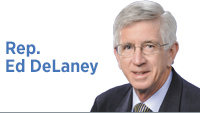Subscriber Benefit
As a subscriber you can listen to articles at work, in the car, or while you work out. Subscribe Now The IEDC and its mega-project near Lebanon (code named LEAP) seem to be tied up in knots.
The IEDC and its mega-project near Lebanon (code named LEAP) seem to be tied up in knots.
The governor has slowed the 9,000-acre project while we figure out whether it has adequate water to service undisclosed but preferred potential occupants. A firm named Pure Development Inc., which is paid millions to manage the massive project, is tied up in litigation, with one of its two owners claiming the business is in “deadlock.” The neighboring city of Lebanon is being accused of cutting off other entrepreneurs in need of water. At least one firm asserts that the city has already breached its commitments to support development.
Did we look before we made this LEAP? Will we as a state look at it in detail now?
It is worth noting that, given the results of the Republican primary, the originator of the LEAP project, Brad Chambers, will not be the next governor. Neither gubernatorial candidate—Republican Mike Braun nor Democrat Jennifer McCormick—has rushed forward to embrace the project. Meanwhile, the taxpayers are at risk thanks to hundreds of millions of dollars spent on farm ground purchased at an average price of some $80,000 per acre.
Happily, Eli Lilly and Co. is going forward with an expansion plan involving some 600 acres east of Interstate 65. Lilly, a known quantity, is proceeding with what looks like a traditional, if large, IEDC project. That leaves some 8,000 acres at LEAP with undefined uses and an uncertain water supply.
Much of the LEAP project is shrouded in secrecy. IEDC has a legitimate need for confidentiality in doing individual deals. But IEDC has gone way beyond this and has kept other details from legislators (myself included) and the public. We have little idea as to how this project is budgeted, who has profited to date, why it is in a relatively dry area, whether we have a competent management team in place or even a clear statement as to what would constitute success. We must do better.
◗ Two suggestions for immediate action
First, the IEDC needs to announce a moratorium on efforts to recruit firms to the project that have massive water needs. This may well be happening naturally, given the current mess. A moratorium needs to be declared forthrightly. Attention might then be paid to other regions that have abundant water resources.
Second, IEDC needs to agree to a full and open legislative hearing to answer the many questions arising almost daily. Otherwise, it will be a major topic in the 2025 legislative budget hearings. Open discussion might be a way to get this project back on track or to trim it back as needed.
◗ Investor risk vs. public risk
The LEAP project takes the ever-growing idea of using public funds to spur private investment to a whole new scale. Our people are already familiar with failed state-supported projects and unfulfilled promises, but not on this scale. Hoosiers are gaining familiarity with the impact of property tax exemptions and TIF districts on local schools and government finances. But this project has potentially greater impact, especially if it were to be repeated elsewhere in our state.
The underlying issue is just whose funds are to be put at risk in the competition to announce new investments. In principle, the American version of a market economy puts private funds, not the public purse, at risk of loss in deploying capital. We have the current version of the Indiana Constitution in part because of a disastrous investment of public funds in canals just as railroads expanded. We don’t want to create a 21st century version of the canal project.•
__________
DeLaney, an Indianapolis attorney, is a Democrat representing the 86th District in the Indiana House of Representatives. Send comments to ibjedit@ibj.com.
Click here for more Forefront columns.
Please enable JavaScript to view this content.

I wish some of that money had been used to support our great public state universities and public education. Having a well educated population is one of the best economic investments.